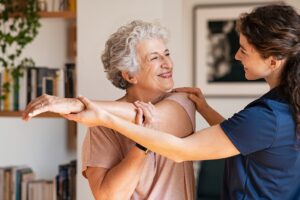 Being physically active is the most important thing you can do to remain mobile and independent, regardless of your age or health status.
Being physically active is the most important thing you can do to remain mobile and independent, regardless of your age or health status.
This cannot be emphasized enough – if you want to move better, you’ve got to move more.
Advertisement
Movement can help keep you mobile in several ways. It can help control weight, keep your muscles and bones strong, your joints working properly, your heart healthy, and your metabolism fired up.
Strength and balance get better with more movement, too, so falls become less likely, and your ability to perform basic daily functions can remain intact.
In addition to doing targeted exercises for muscle strength and flexibility, joint health, and balance, you should strive to increase routine daily physical activities that aren’t formal exercise. Climbing stairs and household chores are great examples.
Of course, if you’re in pain, the idea of doing exercise or moving around may seem impossible. But in most cases, moving will actually help reduce pain. For example, if you have osteoarthritis, regular exercise can help maintain joint function and relieve stiffness while reducing pain and fatigue.
Stronger muscles resulting from movement can also help reduce stress on joints.
How much exercise should you get? For healthy adults, 150-300 minutes of moderate exercise per week, with some happening every day, is recommended. Two sessions of strength training and balance exercise per week are recommended for adults at risk of falling.
Advertisement
If you’re disabled, it doesn’t mean you should completely avoid activity. If you can’t complete 150 minutes of moderate-intensity activity because of chronic conditions, just try and be as physically active as possible. Basically, try to sit less and move more.
Try to find activities that you enjoy. That way, you’ll be more motivated to get up and do them. Also, be aware of your capabilities: if your joints hurt, then don’t try and pace them. Instead, let them pace you. For example, don’t jog if you have sore knees. Cycling, swimming, or water aerobics, which are all low-impact, are much better.
If you’ve had hip or knee surgery, are experiencing joint pain, or have a chronic or unstable health condition, talk to your doctor before beginning an exercise routine.
